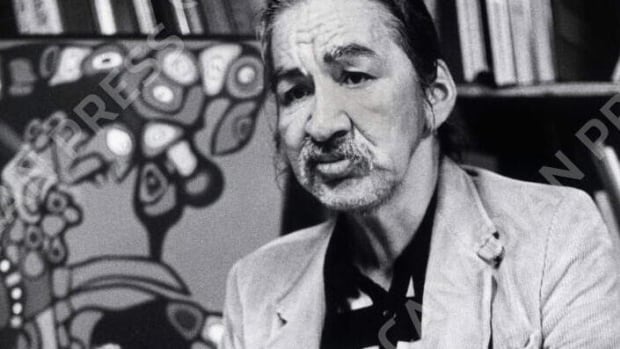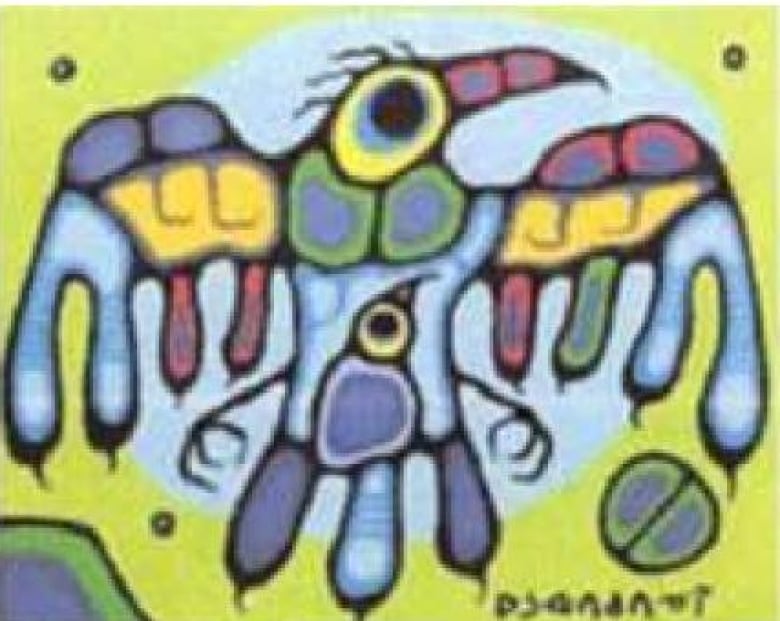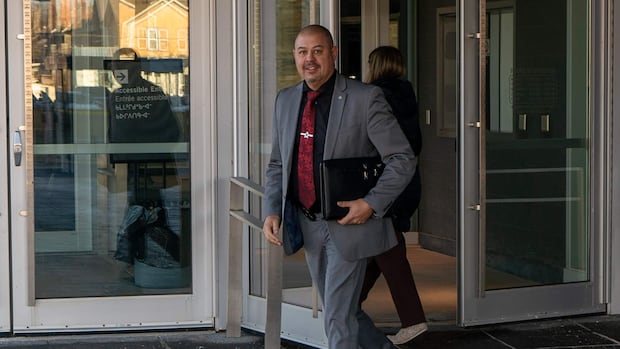
To the untrained eye, the Thunderbird Protects Young print listed for auction earlier this month looked like a great deal.
With the highest bid sitting at under $100, it was an opportunity to take a piece of famed Anishinaabe artist Norval Morrisseau’s work home for cheap. It even said it included a certificate of authenticity, and it was listed on a police auction website.
The catch? It’s a fake, according to the Morrisseau estate.
It’s not clear how the print came to be listed on the website of Police Auctions Canada, which calls itself the country’s official police auction — selling items that were seized, forfeited or found by public municipalities like police services, law enforcement agencies and transit commissions.
Over the years, multiple other fake Thunderbird Protects Young prints have been seized by police during investigations into rings that made fraudulent art attributed to Morrisseau, a key figure in the Indigenous art movement in Canada who died in 2007 at age 75.
Police have called the case “Canada’s largest art fraud investigation in history” and some of those involved have been sentenced in the case. Court documents obtained by CBC News show an identical painting listed under “VOSS Ring Forgeries.”
CBC News contacted Police Auctions Canada, which said it removed the listing pending an investigation. The auction site did not respond to additional questions about the origin of the print.
Unclear who provided print to auction site
The Police Auctions Canada website said it is “not privy to specifics of where the items originated.” The site notes a large portion of the sales go back to help non-profit organizations and community groups.

Both the Thunder Bay Police Service (TBPS) and Ontario Provincial Police (OPP) have been involved in a years-long investigation into the fraud ring, during which more than 1,000 paintings were seized.
“It was not our listing,” said a TBPS spokesperson in an email. “The Thunder Bay Police Service does not work with this specific auction website.”
Multiple OPP detachments are listed on the Police Auctions Canada website. When asked about the print via email, an OPP spokesperson said they did not have any information about the auctions.
Print ‘obviously’ fake: Morrisseau estate
The court documents obtained by CBC News show 11 prints titled Thunderbird Protects Young were seized by police. They are listed as Voss ring forgeries “Created at the Direction of James WHITE.”
David Voss pleaded guilty in June 2024 to forgery and uttering forged documents for operating an art fraud ring out of Thunder Bay between 1996 and 2019. He was sentenced to five years in prison for his role in overseeing a “paint-by-numbers” assembly line to make thousands of forgeries.
James White of Essa Township was another one of the people charged in March 2023 in connection with the art fraud ring. His case is still before the courts.
The print that was on the Police Auctions Canada site is numbered, and the print number does not match the numbers of any of the 11 prints in the list. The certificate of authenticity on the back of the auctioned print reads “WHITE DISTRIBUTION LIMITED” at the bottom.
The canvas painting the prints were based on was listed as one of the identified “VOSS Ring Forgeries” in court documents.
That means it’s impossible that the auction print or any of the seized Thunderbird Protects Young prints are authentic, said Cory Dingle, executive director of the Morrisseau estate.
“This replication of that fake painting is obviously therefore a fake print,” said Dingle.
“Police selling a fake print of a fake painting is ironic in a sense,” he said. “But do we blame them? No.”
Dingle said the sheer number of fake paintings and prints flooding the market makes it difficult for a layperson to distinguish what’s authentic. He said he wants to see more resources available to both police and the public to help identify fraudulent art.
Reselling fakes illegal but hard to pursue in court: lawyer
Fraudsters alone aren’t solely to blame for the fake art flooding the market — unscrupulous retailers can enable the proliferation of fraudulent works, said Paul Bain, a lawyer and partner at Dickinson Wright law firm in Toronto.
The lead investigator in the case against Gary Lamont reacts after seeing the sentence handed down in court and says he hopes it brings the victims some closure.
Bain, who has expertise in art law, said this is part of the reason fraudulent copies of Morrisseau’s creations became so widespread.
“There were so many people involved down the line, auctioneers, people selling and reselling what they knew or ought to have known was a fake work of art,” said Bain.
“If it’s [sold] knowingly, then you’re essentially part of the fraud.”
It’s not easy to pursue alleged art fraudsters in Canadian courts.
“We have copyright rules, but they are expensive to enforce, and unless someone’s making millions out of this, police are probably not going to get involved,” said Bain.
Artists, gallery owners say fraud cuts into profits
“Literally every Native artist that I know has had their art stolen,” said Erin Brillon, a Haida and Cree artist who’s a business owner.
Most artists can’t afford to hire specialized art lawyers, she said, and the sheer number of fakes out there means it would be a long, expensive battle to fight in courts.
“It’s like playing a game of whack-a-mole because you get one shut down and then there’s like 10 more that pop up. So it’s like a never-ending battle, and we just don’t have the time or the resources to be able to deal with it,” said Brillon, who owns Totem Design House in Courtenay, B.C.
Some people create fake Indigenous art, while others steal real designs from Indigenous artists and sell knockoffs, said Brillon.
Her husband, K’ómoks and Kwakwa̱ka̱’wakw artist Andy Everson, has seen his Every Child Matters logo design being resold by other businesses, including online stores located overseas.
Brillion said art fraud and design theft mean Indigenous artists don’t get to profit from their work. Low-priced fakes flooding the market also presents competition for legitimate Indigenous artists.
“We have an upcoming generation of young Indigenous artists that are now trying to find their way in the world and their artworks are going to be harder to sell,” said Brillon.
